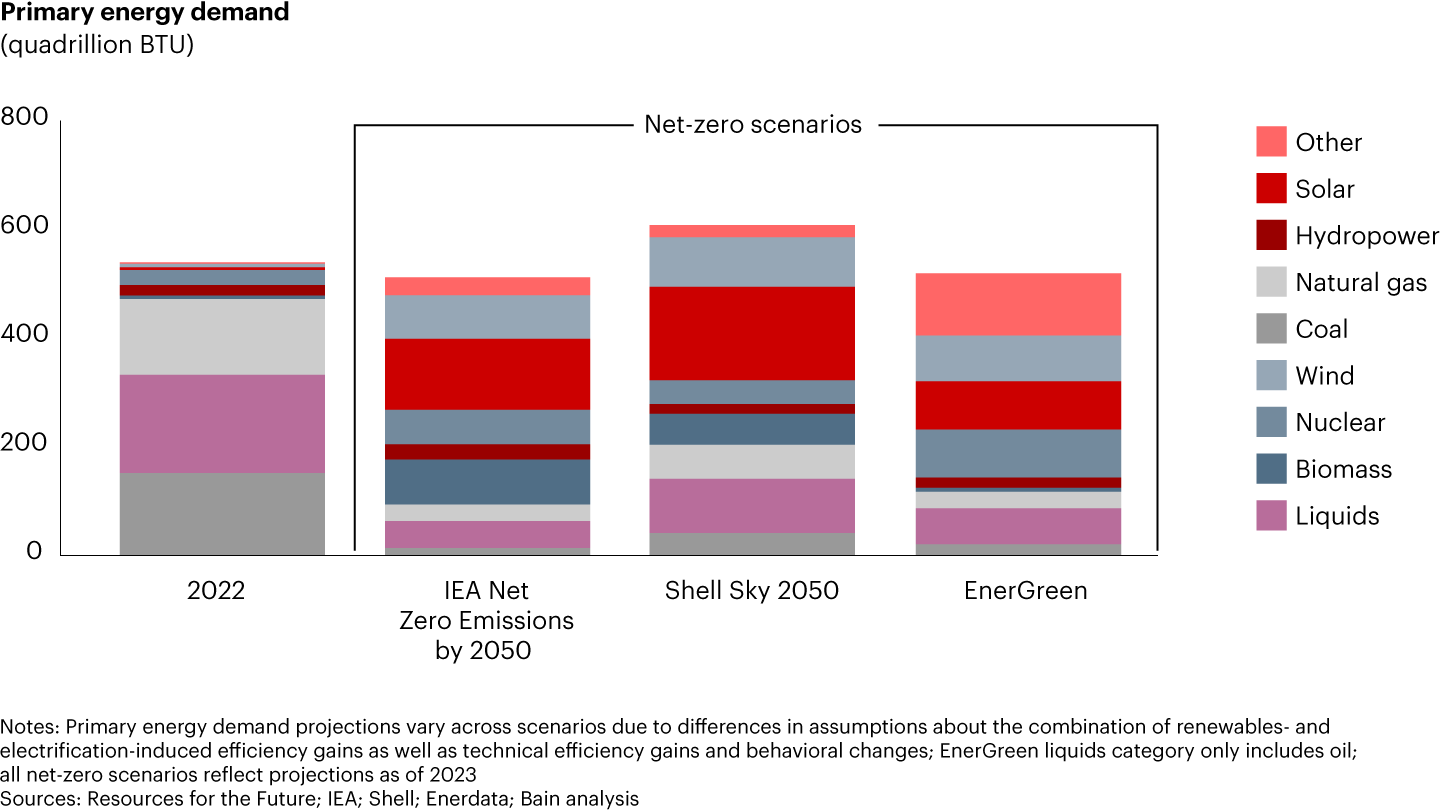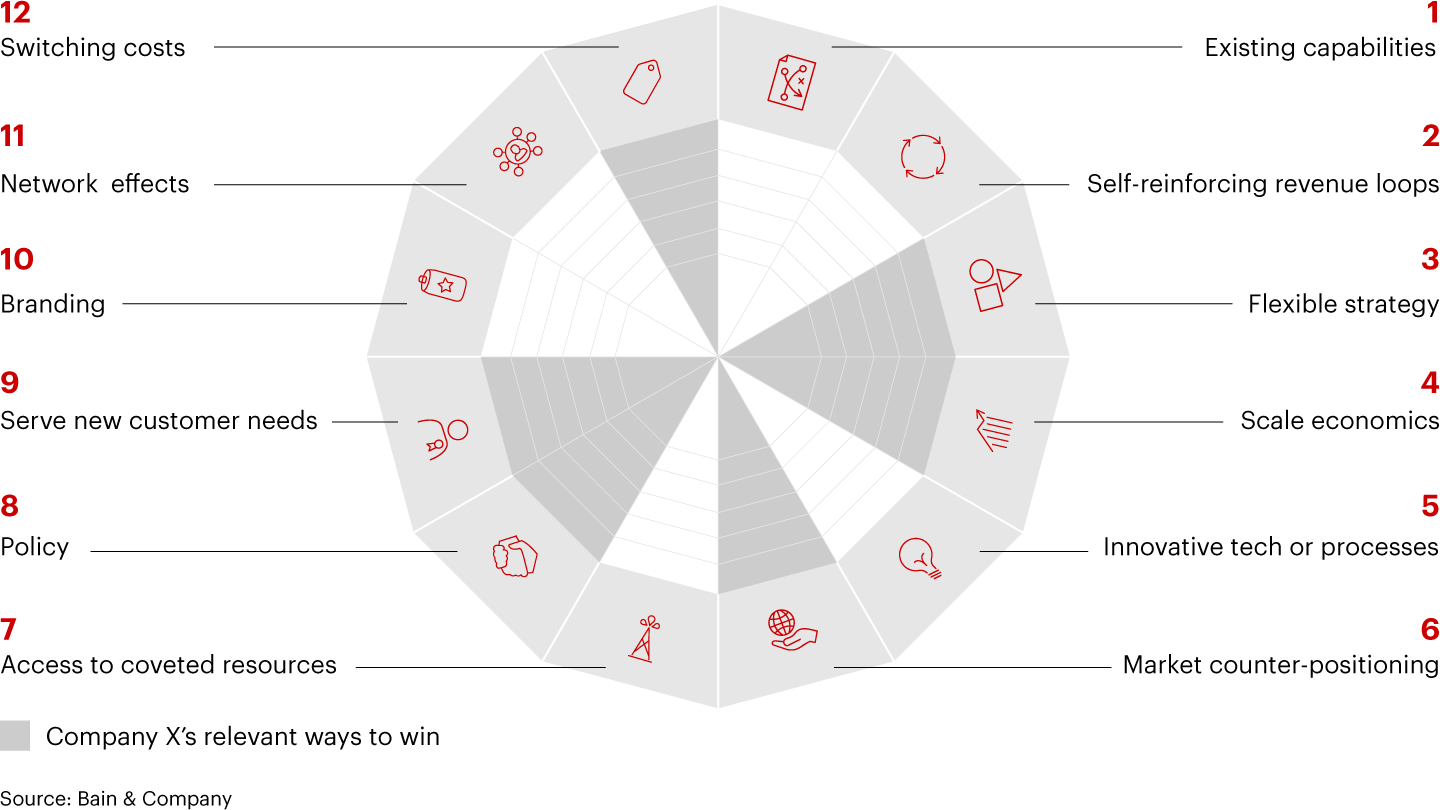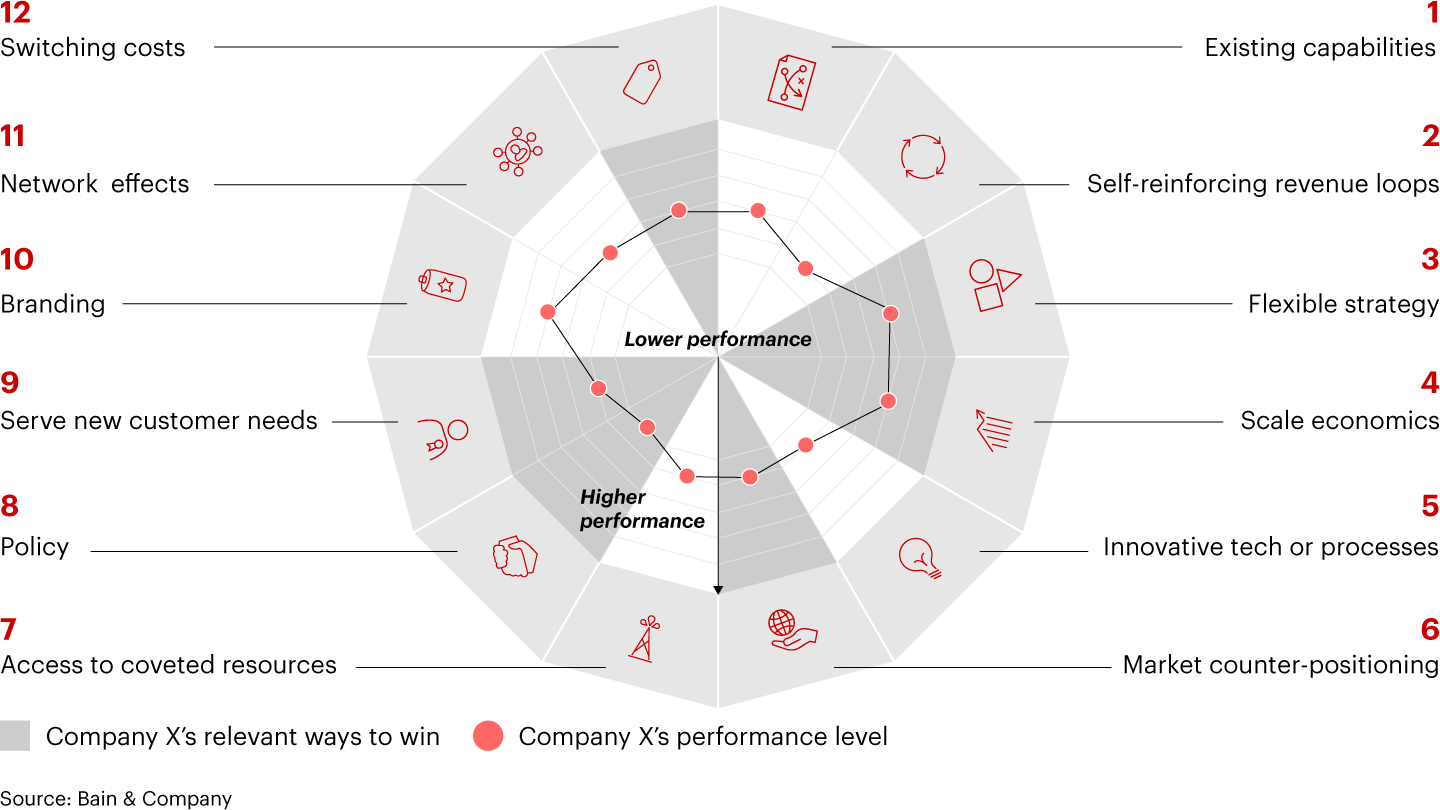The Visionary CEO’s Guide to Sustainability

概要
- Surging demand for data center power, rising capital costs, and other factors are intensifying the challenges of the energy transition.
- Although they remain committed to decarbonization, many companies are focusing on investments with clearer paths to a return.
- Rather than targeting 2050, emerging energy transition leaders are developing strategies for “203X”—the next 5 to 15 years.
- To start, they’re evaluating what they know (and don’t) about 203X, identifying their competitive advantages, and assessing their organizational capabilities.
This article is part of Bain's 2024 CEO Sustainability Guide
As businesses encounter the practical realities of delivering on long-term decarbonization commitments, executives are realizing that success in the energy transition will require a pragmatic, urgent focus on moving from one stepping-stone to the next on the path to net zero.
It will take change at an unprecedented scale and pace to solve the dual challenge of the energy transition—increasing the world’s energy supply to meet growing demand while curbing carbon emissions. This challenge was daunting even before artificial intelligence began to grow at an explosive rate in late 2022. The resulting surge in demand for data center power, combined with the ongoing effort to “electrify everything,” will put immense pressure on electrical grids in the coming years while complicating decarbonization efforts. At the same time, rising capital costs, geopolitical tensions, supply chain constraints, and regulatory complexity are only exacerbating the challenge.
As energy transition initiatives accelerated in recent years, many investors and companies anchored their efforts around the distant-future goal of achieving net-zero carbon emissions by 2050, operating on the assumption that immediate steps were needed in order to achieve that end goal. However, as they’ve ramped up decarbonization investments, many companies have found out the hard way that it’s possible to lose a lot of money between now and 2050. Although most remain committed to decarbonization, companies are increasingly focusing on transition-related investments with clearer paths to generating a return.
Still, it remains unclear what the mix of energy generation sources and emissions abatement technologies will look like in a net-zero end state, with a range of potential combinations (see Figure 1). The pace and roadmap for reaching that end state are even more opaque.


It’s understandable that executives would have reservations about making investment and business decisions based on an uncertain future that’s more than 25 years away, possibly long after their tenures have ended. But a better way is emerging. Some companies are refocusing on strategic and financial fundamentals that explicitly recognize the dual challenge imperative but prioritize practical execution in the near term. Rather than taking a 2050 lens, they’re developing an energy transition strategy geared toward winning in the next 5 to 15 years—a less rigid, but more pressing and actionable, time horizon that we’re calling “203X.”
These companies are discovering that focusing on 203X is powerful and pragmatic. It inspires them to imagine what’s possible while holding them accountable for what’s practical. It doesn’t downplay the urgency to act; it highlights it. Success in a very different future demands having the conviction to make bold moves now to secure advantages—geographic, technological, competitive—that will be meaningful in 203X and beyond.
Going forward, navigating the energy transition will require continually forecasting 5 to 15 years ahead, mapping key stepping-stones, and dynamically adjusting strategy in a thoughtful, balanced way. This approach can mitigate uncertainties that paralyze action, highlight potential disruptions to guard against, and empower resilient decision making.
Developing a stepping-stone strategy
Even when companies recognize the benefits of a stepping-stone approach to the energy transition, many aren’t sure how to start. Emerging leaders are forming their strategy by focusing on three things.
1. Get clear on what you know and what you don’t. Anchoring on 203X instead of 2050 helps narrow strategic considerations to a more manageable number and focus the conversation. Leading companies contemplate the industry variables likely to remain relatively steady between now and 203X, as well as the “known unknowns” that they’ll need to develop resilience against. By identifying the external factors that could affect their strategy and grouping these factors by their degree of predictability, organizations can develop a plan that prioritizes investments based on a range of possible outcomes. This can illuminate potential pathways to capitalize—and their trade-offs.
Executives may be surprised by how much they can project with reasonable confidence within the 203X window, such as the relatively predictable development speed of energy technology (constrained by physics) and the relatively defined speed and scale limitations of infrastructure construction. Essentially, this means companies will be operating within today’s parameters for much of 203X. That should feel freeing for executives’ energy transition decision making. Although they can’t ignore long-term technology trends, some things that might be possible by 2050 are off the table (for now).
Meanwhile, identifying unknowns, such as the future cost of capital, can make the strategy adaptable to less predictable external disruptions. It also helps avoid irreversible commitments that depend on a worldview that may change.
As part of a durable and resilient strategy, companies should continuously consider and plan for uncertainties, including extreme-but-plausible scenarios where the range of outcomes can be estimated. History has shown that certain disruptive events will happen, even if executives don’t know when or how significant they’ll be (think weather or wars that hobble energy supply chains). Once the range of plausible scenarios is understood, companies can define and track key signposts that would trigger strategic adjustments.
Maersk, the global shipping and logistics company, has launched the first vessels in a planned fleet of around 25 container ships that can sail on green methanol in addition to biodiesel and conventional bunker fuel. Maersk has also begun retrofitting existing ships with the same dual-fuel engines. This move gives the company optionality as green methanol technology matures, plus resilience against the pace of its production, while helping fulfill the company’s 2030 carbon-reduction goals on the path to its 2040 net-zero emissions target.
2. Identify the most relevant ways to win. Succeeding in the energy transition will likely require a portfolio of strategic advantages that, together, will allow companies to navigate even the most dramatic shifts in the landscape. Emerging leaders are evaluating their companies against 12 potential competitive levers and leaning into the ones that are most relevant or important to their business model (see Figure 2).


These companies are also trying to anticipate which approaches their competitors are pursuing, or are most likely to pursue, and how those choices may affect them.
A prudent portfolio of competitive levers focuses on a few priority areas while recognizing crucial interdependencies. For example, innovative technology may be relevant, but if the technology requires resources that are constrained, securing coveted access will also be critical to the company’s success.
3. Assess performance and capabilities across key levers. Leading companies conduct an honest assessment of their current performance across the chosen strategic areas of focus. It’s crucial to be realistic about which capability gaps to close and how. Thoughtful investment of scarce internal resources will be essential, and acquisitions and partnerships may be an important part of succeeding in the energy transition.
By marrying the short list of competitive levers with an assessment of performance and capabilities in those areas, companies can build a robust execution roadmap (see Figure 3).


With electric vehicle sales rising, a chemical manufacturer looked to capitalize on surging demand for critical battery materials. The company assessed technology and market trends, and it ran potential scenarios to help identify its key strategic choices. For example, what’s the right mix for its portfolio of product types and battery chemistries, as well as resource types and locations? Where should it locate its resource base and processing operations? Which customers and value chain intermediaries should it focus on, and how would that differ from its current customer base?
The assessment helped the company develop a 10-year growth strategy with clear short-term priorities (e.g., supplier relationships, production expansion, technology roadmaps) and a set of signposts to monitor that would prompt updates to the strategy (e.g., technology advances, government incentives for EVs). Despite the variability in material prices and fluctuations in near-term EV demand, the company’s flexible long-term strategy enables it to adapt nimbly to such headwinds.
Or consider how one retail energy firm is transforming itself into a consumer-centric services company. Faced with diminished growth prospects in its core business, customer demand for sustainability, and competition from residential solar and other new energy products, the firm needed to evolve. The leadership team recognized this, but some members were skeptical the company could execute such a pivot, given the organization’s limited success entering new markets in the past.
To succeed this time, the company developed a long-term growth strategy with a clear roadmap. It conducted detailed market assessments for potential new businesses, defined the uncertainties most likely to affect the company’s strategy, and stress-tested the organization’s capabilities by simulating potential disruption scenarios. The company also ran a series of “micro-battles”: discrete, time-boxed initiatives that rapidly bring strategic choices to action and formulate ways to scale the results. Through this effort, the company established a repeatable, structured model for evaluating and scaling new businesses. Ultimately, the company projects its new strategy could deliver hundreds of millions of dollars in EBITDA in the coming years.
Seizing the moment
We’re in an unprecedented moment in history, facing tremendous challenges but also incredible opportunities. Emerging leaders know that success in the energy transition requires preparedness and durability. They’re developing strategies that capitalize on known factors or those they can reasonably constrain, while becoming adaptable to those they cannot. Above all, they’re moving quickly to capture advantages that will define their strategic position in 203X and beyond.
The authors wish to thank Annabell Marlen Hillenbrand, Ellyn Gray, and Hannah Bingley for their contributions to this article.